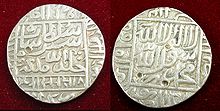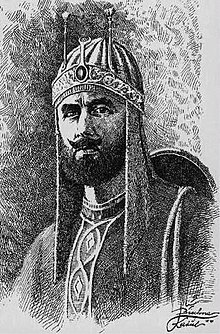Sher Shah Suri

Sher Shah Suri ( Persian فريد خان شير شاہ سوري, DMG Farīd Ḫān Šer Šāh Sūrī ; born around 1486; died May 22, 1545 ) was a ruler of Pashtun origin in northern India , whose government interrupted the Mughal period . His short-lived dynasty after their place of origin Sur in today's state of Bihar Sur Empire called.
biography
He was the son of a little feudal man in Bihar and had a varied career: scholar, civil servant, tutor to a prince, minister, rebel and finally sultan . He was briefly in the service of the founder of the Mughal Empire, Babur († 1530), but was then able to return to his ministerial post in Bihar, where he broke away from Babur's successor Humayun in 1531 .
Sher Shah led two campaigns to Bengal (1534 and 1537), which called the Mughal ruler Humayun on the scene, but who acted too slowly and indecisively, so that there was an uproar in the capital Delhi and he had to turn back. Sher Shah defeated the opium-addicted Mughal in two battles in 1539/40 and chased him to Persia , where he found asylum. In 1543 he conquered the Rajput Marwar empire, but had to cede it to the expelled Raja Maldeo Rathore a year later .
During his reign, Sher Shah built up a centralized administration and police force, reformed the coinage and tax system, improved the judiciary, founded refuges, hospitals and free kitchens for the poor, laid the first major highway (now part of the Grand Trunk Road ) with trees and rest houses and wells through North India and organized a postal service.
Sher Shah died in a powder magazine explosion during the siege of the Rajput fortress of Kalinjar, held by the Chandella princes . In addition to his tomb mausoleum, he had the Qila-i-Kuhna Mosque built in the 'Old Fort' ( Purana Qila ) of Delhi, which was repaired at the same time. Humayun and the resurgent Mughal Empire were able to build on his measures when they returned to power; In his honor the octagonal and two-story Sher Mandal in the 'Old Fort' of Delhi, begun by Babur and completed by Humayun, was renamed.
mausoleum
As early as 1540, Sher Khan Suri began building his tomb at Sasaram in the southwest of today's state of Bihar , which, according to an inscription, was completed on August 16, 1545, three months after his death. It is located on a raised platform in the middle of a square artificial lake and can only be reached via a causeway with a bridge. On the square floor plan of the defensive-looking substructure stands an octagonal building with three arcade arches on each side, which enclose an inner corridor around the actual core building; a crenellated parapet wall behind which eight Chhatri pavilions are hidden forms the upper end. A second octagon - also with eight chhatris - belongs to the central structure; it forms the substructure for the central dome , which ends with an upturned lotus blossom and a somewhat alienated, but basically Hindu- influenced Amalaka - Kalasha motif.
In terms of time and style, the Sher Shah Suri's mausoleum stands between the octagonal tomb of Mohammed Shah IV (around 1445) in the Lodi Gardens and the Humayun mausoleum (around 1570); both buildings are in Delhi.
More surids
His son and successor Islam Shah Suri died after eight years of reign in October 1553. His son was murdered by Mubariz Khan, Islam Shah's cousin, who then ascended the throne as Muhammad Adil Shah . He left the business of government and leadership of the army to the Hindu Hemu while indulging himself in pleasure. The unlawful accession to the throne of Muhammad Adil Shah led to unrest, and a famine caused by long periods of drought increased the state of general discontent and encouraged other Suri princes to seize power. Mogul Humayun took advantage of the desperate situation and prevailed against the resistance of Sikandar Shah Suri. In mid-1555, Humayun was able to retake Delhi. But he died in January 1556. Muhammad Adil Shah Suri was killed in April 1557 in Bengal.
literature
- Bamber Gascoigne: The Mughals. Splendor and greatness of Mohammedan princes in India. Prisma Verlag, Gütersloh 1987, ISBN 3-570-09930-X .
Web links
- Sher Khan Suri, short biography - picture + info (English)
- Coin Sher Shah Suris - photo + brief information (English)
Individual evidence
- ↑ Catherine B. Asher: The Mausoleum of Sher Shāh Sūrī. In: Artibus Asiae. Vol. 39, No. 3/4, 1977, pp. 273-298, here p. 273, doi : 10.2307 / 3250169 .
- ↑ Archaeological Survey of India - Shershah Suri's Tomb ( Memento of the original from October 10, 2011 in the Internet Archive ) Info: The archive link was inserted automatically and has not yet been checked. Please check the original and archive link according to the instructions and then remove this notice.
- ↑ Abu 'l-Fazl: The Akbar-nama. Translation H. Beveridge. Low Price Publication, Delhi 1993. Vol. 1, pp. 616-619 and Vol. 2, pp. 89-90.
- ^ John F. Richards: The Mughal Empire. The new Cambridge History of India, I: 5. Cambridge University Press, Cambridge 1993. p. 12.
- ↑ Abu 'l-Fazl: The Akbar-nama. Translation H. Beveridge. Low Price Publication, Delhi 1993. Vol. 2, p. 90.
| predecessor | Office | successor |
|---|---|---|
| ( ruled by the Mughal Empire ) |
Sultan of Delhi ( Suri dynasty ) 1540–1545 |
Islam Shah Suri |
| personal data | |
|---|---|
| SURNAME | Sher Shah Suri |
| ALTERNATIVE NAMES | Sher Shah |
| BRIEF DESCRIPTION | Indian ruler |
| DATE OF BIRTH | around 1486 |
| DATE OF DEATH | May 22, 1545 |

